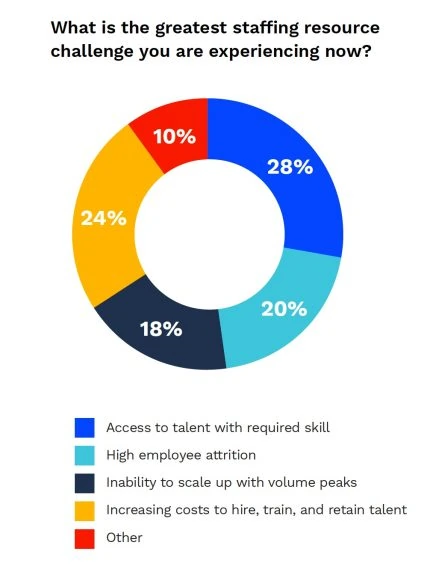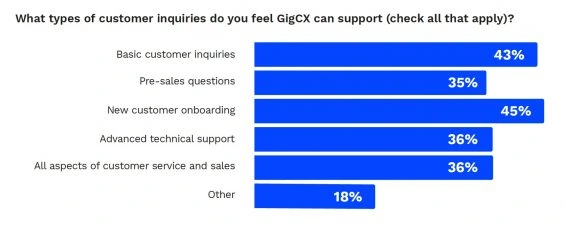Your Genesys Blog Subscription has been confirmed!
Please add genesys@email.genesys.com to your safe sender list to ensure you receive the weekly blog notifications.
Subscribe to our free newsletter and get blog updates in your inbox
Don't Show This Again.

Gig work has emerged as a flexible model for individuals to earn a bit extra while working for their favorite brands. The number of gig workers globally is projected to be 10% of the freelance population worldwide by 2023. That’s 78 million people, according to Mastercard research.
Gartner argues that gig or contingent workers represent approximately 15–25% of the global workforce today, while others say 36% of US workers are involved in the gig economy. Whichever numbers you look at, gig work is growing and likely is here to stay.
Contact center work is among the areas where the gig economy is on the rise — a model where fans of your brand provide customer service for fellow customers. Many organizations find that gig workers are brand advocates or super users, ideally positioned to support customers through sales and service channels.
The companies hiring these enthusiasts can supplement their traditional contact center operations with individuals who have an unparalleled level of product knowledge. Because these users are already product experts, it reduces onboarding time, with zero cost of training and a super-fast speed to competency.
However, the main benefit of the model, that companies are simply in awe of, is the fact that these people provide the most incredible customer experience. They are, themselves, expert customers, so they really relate to the customers they’re helping.
These super users form a gig crowd that gives companies easy access to an on-demand workforce. Gig workers can be anywhere in the world and enjoy the flexibility to earn money completely on their own terms, without having to commit to a schedule.
Ninety-one percent of the 600 CX gig workers surveyed by Limitless in 2022 said they started GigCX (Gig for Customer Service) because of the flexibility it offers. And 90% said it has improved their lives, while 83% said it’s had a positive effect on their mental well-being.
Savvy CX leaders are already using gig workers to supplement their service teams. Nearly three-quarters of customer service managers we surveyed in the US and UK have added or plan to use gig talent in the next two years.
It’s a shrewd solution when managers say their greatest resourcing challenges are access to talent with the required skills, high employee attrition, and employees asking for flexible work schedules. It’s also cost-effective because you’re only paying for successfully resolved cases and can vary the rate based on the complexity and language of each task.

Here’s how to seamlessly integrate gig super users into your customer service operations.
Dig into your customer base to find the super users.
Your customer base is a great starting point in the search for gig super users. They might already be providing informal advice on social media and in forums — or participating in a loyalty program.
They could be in Alabama or Melbourne or Zurich; they could be a 21-year-old student earning a side income; a 40-year-old, stay-at-home parent keeping connected to the workforce; or a 65-year-old retiree supplementing their finances. They could be a native speaker of one language or fluent in three.
They might also work full-time but have spare time and an affinity for your company, services or products. The demographics are less important than their love of your brand and their desire to help others. Invite them to become a brand ambassador who gets paid to help other customers.
Make sure they’ll provide great customer service.
Being an enthusiast is a great starting point, but advocates also need to have solid communication skills to provide guidance to other customers. Being a gig super user means having to demonstrate their knowledge of and proficiency with your products or services, as well as their interpersonal and communications skills.
Set them up for success.
Gig super users are freelancers that come with existing skill sets and knowledge of your company’s products and services. It’s key to ensure they’re supported and have access to information that will help them assist customers in the best way. This is best done using a GigCX platform designed for that purpose.
In some cases, you might want gig workers to start by handling inquiries that don’t require access to internal systems or customers’ personal data. Instead, they can focus on potentially complex product- or services-oriented interactions.
As the company’s confidence in the gig model increases, gig super users can be further qualified to handle inquiries that require systems or data access.
Over one-third of CX leaders Limitless surveyed feel that CX gig workers can handle new customer onboarding. And 43% say they’d be adept at handling basic customer issues.

Get comfortable with flexibility.
Provide clear expectations on which CX tasks gig super users will handle, and then give them control of which of those tasks they choose. There should be no penalties if they decide not to do specific tasks.
Usually, there’s an art and science to forecasting and scheduling. With gig super users, the aim is to offer the flexibility to work on their own terms.
This is vital because flexibility is the greatest attraction for more than half of survey respondents. Worker motivation, the size of the gig crowd, the law of averages, and notifications and gamification ensure response times are short, completions are high, and CSAT is outstanding.
Connect people and technology.
Just as in your contact center, it’s essential to send the right ticket to the best resource — whether that’s a chatbot, GigCX super user or a traditional call center agent with the appropriate skills. Additionally, it should be as easy for a gig super user to escalate or transfer an interaction or ticket as any other agent on your team.
Ensure the technology you use to support gig super users easily integrates with your existing CX technologies.
Blending full-time and gig super users into your CX workforce has a myriad of benefits for your company and your CX staff. Your company has easier access to highly skilled and engaged brand advocates — those enthusiasts get compensated for sharing their expertise on their own terms.
The best part: 81% of consumers we surveyed said they’d be more likely to buy a product after speaking with a CX gig super user who’s an expert in a company’s product or service. With so many benefits to the top and bottom lines, CX leaders will continue to embrace gig work as a key pillar of their employee and CX strategy.
Subscribe to our free newsletter and get blog updates in your inbox.